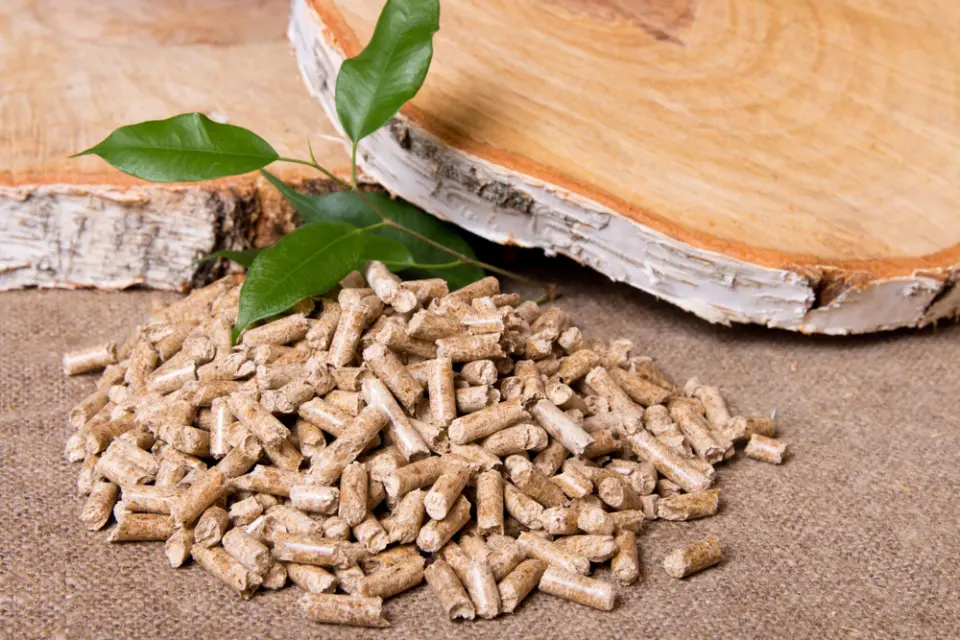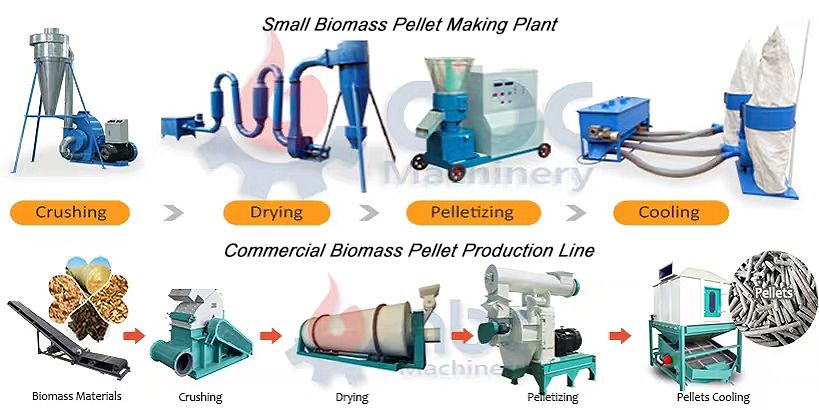Biomass pellets have emerged as a critical component in the transition to renewable energy sources, offering significant environmental and economic benefits. The process of converting biomass into pellets, a form of densified energy, plays an essential role in enhancing the efficiency of renewable energy generation, from power stations to residential heating systems. In this blog, we will explore the fundamentals of biomass pellets, their production process, their role in power generation, and the growing global market for these versatile biofuels.

What are Biomass Pellets?
Biomass pellets are created by compressing biomass material—such as agricultural residues, forestry waste, or other organic matter—into cylindrical shapes that are typically around 1 cm long. This process of size reduction, drying, and compression is known as pelletizing, and its primary purpose is to increase the density of biomass for easier handling and transportation. Pellets are often used for generating electricity in power plants or providing heat in residential wood heaters, industrial boilers, and commercial furnaces.Types of Biomass Pellets:
- White Pellets: These are the most commonly produced pellets, typically having a moisture content of 7-10%. White pellets are primarily made from forestry residues such as sawmill waste (e.g., sawdust, offcuts) and harvest residues (e.g., small branches). They are widely used in power stations and heating systems.
- Black Pellets: Produced through advanced processes like torrefaction or steam-explosion (SE), black pellets have a lower moisture content (1-5%) and higher energy density compared to white pellets. Torrefaction involves heating biomass at 200-340°C in an oxygen-deprived environment, while SE pellets undergo a rapid steam-explosion that results in smaller particles and enhanced properties, such as increased calorific value and bulk density. Black pellets also offer improved storage characteristics with reduced water absorption.
Pellet Production Process
The production of biomass pellets is a multi-step process designed to ensure the creation of a consistent and high-quality product. Below is a breakdown of the key stages involved:
- Pre-treatment:
- Demineralization: This step removes inorganic materials like calcium carbonate from the biomass, typically by treating it with dilute hydrochloric acid (HCl).
- Deproteinization: To remove proteins, biomass is treated with sodium hydroxide (NaOH) at elevated temperatures (65-80°C).
- Decolorization: This process removes pigments from the biomass, often achieved through the use of organic solvents or activated charcoal.
- Deacetylation: This crucial step involves treating the biomass with concentrated NaOH at high temperatures (100-160°C) to convert chitin into chitosan. The degree of deacetylation (DD) is controlled by varying the reaction time and temperature, with typical commercial DD levels ranging from 70-95%.
- Post-treatment:
- Neutralization: The treated biomass is neutralized and washed to ensure that the pH is brought to a safe level (7.0-7.5).
- Drying: The biomass is dried using methods such as spray drying or freeze-drying, depending on the moisture content.
- Milling and Sieving: The pellets are milled and sieved to achieve uniform particle sizes for better combustion performance.
Pellets in Power Generation
Biomass pellets are primarily used in power generation, where they can either replace or supplement traditional fossil fuels like coal. The use of biomass pellets for electricity generation can occur in two main scenarios:
- Standalone Biomass Power Stations: These power plants are entirely fueled by biomass pellets, and they produce electricity by burning pellets in dedicated biomass boilers. For example, large biomass power stations such as the Drax Power Station in the UK rely heavily on biomass pellets to meet a significant portion of the electricity demand.
- Co-firing with Coal: Biomass pellets are often co-fired with coal in existing coal-fired power plants. Co-firing refers to the process of mixing a portion of biomass pellets with coal to reduce greenhouse gas emissions and decrease the dependency on fossil fuels. This process is particularly beneficial as it requires minimal modifications to existing coal-fired plants. In some plants, up to 10% of the energy can come from biomass pellets, providing a cleaner, renewable source of energy.
Co-firing Benefits:
- Energy Efficiency: When using biomass pellets for co-firing, minimal adjustments to the boiler and fuel feeding systems are required. The energy content of one tonne of white pellets is approximately 4,800 kWh, which is slightly lower than the 6,000 kWh in one tonne of coal. However, black pellets offer a much closer calorific value to coal, making them a more efficient option for larger co-firing ratios.
- Sustainability: Biomass pellets contribute to reducing the overall carbon footprint of power generation by replacing fossil fuels with a renewable source of energy. As biomass is part of the natural carbon cycle, its combustion results in the release of carbon that is quickly reabsorbed by new plant growth, creating a carbon-neutral cycle.

Economic and Environmental Benefits of Biomass Pellets
Biomass pellets provide numerous environmental and economic benefits, making them an attractive alternative to traditional fossil fuels:
- Renewable Energy Source: Biomass is a renewable source of energy, which, when sourced sustainably, can help reduce dependence on non-renewable resources like coal, oil, and natural gas.
- Carbon Neutrality: The use of biomass pellets reduces the amount of carbon emissions that would otherwise come from coal combustion. Although burning pellets does emit carbon, it is part of the short-term carbon cycle, unlike the long-term carbon release from burning fossil fuels.
- Waste Management: Biomass pellets are often produced from agricultural and forestry residues, helping to repurpose waste materials that would otherwise be discarded. This waste-to-energy approach reduces environmental pollution and waste in landfills.
- Local Economic Growth: The production and use of biomass pellets can stimulate local economies by creating jobs in various sectors, from biomass farming to transportation and pellet manufacturing.
The Global Pellet Market: A Growing Industry
The global market for biomass pellets has seen impressive growth in recent years. From 2012 to 2018, the global production of wood pellets grew by 12%, from 19.5 million metric tonnes (MMT) to 35.4 MMT. The primary demand for these pellets comes from Europe, Asia, and North America, with a growing interest in countries like the United States and China to adopt pellet-based solutions for power generation and heating.Market Segmentation:
- Wood Pellets: The majority of pellets are made from wood, including sawmill residues, wood chips, and bark.
- Agricultural Residues: Pellets can also be made from agricultural residues such as wheat straw, sugarcane bagasse, and grape marc.
As the global demand for renewable energy grows, the market for biomass pellets is expected to expand further, with countries transitioning to cleaner energy sources to meet international climate goals.
Sustainability Considerations and Future Outlook
While biomass pellets offer substantial environmental benefits, their production must be managed sustainably. Ensuring that the biomass used for pellet production is sourced from sustainably managed forests and agricultural systems is essential to prevent deforestation and other environmental impacts. Furthermore, technologies like Bioenergy with Carbon Capture and Storage (BECCS) are being explored to further reduce the carbon footprint of biomass power generation, with the potential for achieving net-negative emissions.As the world moves toward a more sustainable energy future, biomass pellets will continue to play a crucial role. Their ability to reduce reliance on fossil fuels, create jobs, and provide a renewable energy source makes them an essential component of global energy strategies. With continued innovation and investment, biomass pellets hold significant promise for addressing energy needs while combating climate change.
Conclusion
Biomass pellets represent a key renewable energy solution, offering both economic and environmental advantages. With their growing role in power generation, co-firing with coal, and their potential for use in residential heating systems, biomass pellets are helping pave the way toward a more sustainable future. However, for biomass pellets to remain truly sustainable, careful attention must be paid to sourcing, production practices, and the integration of advanced technologies such as BECCS. As the global demand for renewable energy continues to rise, biomass pellets will undoubtedly play an increasingly important role in the energy mix.